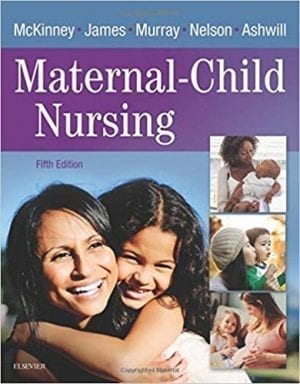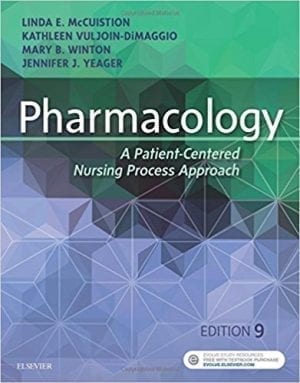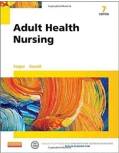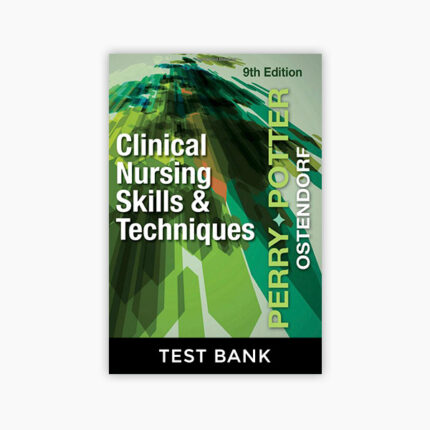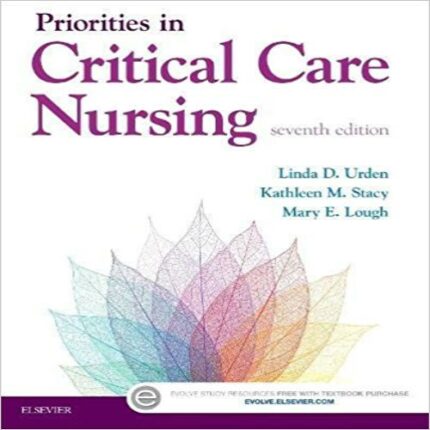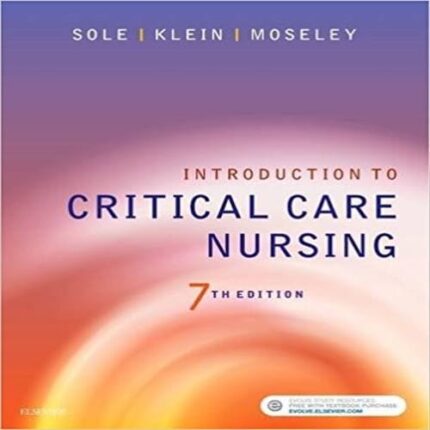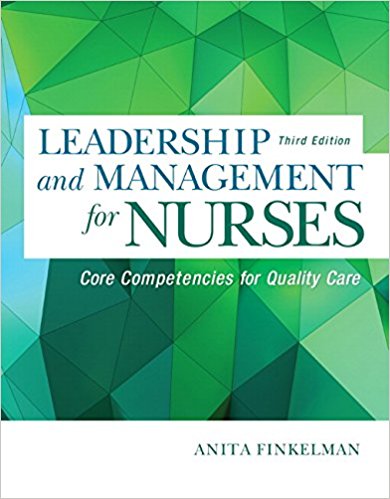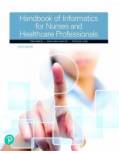Test Bank for Maternal Child Nursing 5th Edition by McKinney
Chapter 01: Foundations of Maternity, Women’s Health, and Child Health Nursing
MULTIPLE CHOICE
- Which factor significantly contributed to the shift from home births to hospital births in the early 20th century?
| a. | Puerperal sepsis was identified as a risk factor in labor and delivery. |
| b. | Forceps were developed to facilitate difficult births. |
| c. | The importance of early parental-infant contact was identified. |
| d. | Technological developments became available to physicians. |
ANS: D
Technological developments were available to physicians, not lay midwives. So in-hospital births increased in order to take advantage of these advancements. Puerperal sepsis has been a known problem for generations. In the late 19th century, Semmelweis discovered how it could be prevented with improved hygienic practices. The development of forceps is an example of a technological advance made in the early 20th century but is not the only reason birthplaces moved. Unlike home births, early hospital births hindered bonding between parents and their infants.
PTS: 1 DIF: Cognitive Level: Knowledge/Remembering
REF: p. 1 OBJ: Integrated Process: Teaching-Learning
MSC: Client Needs: Safe and Effective Care Environment
- Family-centered maternity care was developed in response to
| a. | demands by physicians for family involvement in childbirth. |
| b. | the Sheppard-Towner Act of 1921. |
| c. | parental requests that infants be allowed to remain with them rather than in a nursery. |
| d. | changes in the pharmacologic management of labor. |
ANS: C
As research began to identify the benefits of early extended parent-infant contact, parents began to insist that the infant remain with them. This gradually developed into the practice of rooming-in and finally to family-centered maternity care. Family-centered care was a request by parents, not physicians. The Sheppard-Towner Act of 1921 provided funds for state-managed programs for mothers and children. The changes in the pharmacologic management of labor were not a factor in family-centered maternity care.
PTS: 1 DIF: Cognitive Level: Knowledge/Remembering
REF: p. 2 OBJ: Integrated Process: Teaching-Learning
MSC: Client Needs: Psychosocial Integrity
- Which setting for childbirth allows the least amount of parent-infant contact?
| a. | Labor/delivery/recovery/postpartum room |
| b. | Birth center |
| c. | Traditional hospital birth |
| d. | Home birth |
ANS: C
In the traditional hospital setting, the mother may see the infant for only short feeding periods, and the infant is cared for in a separate nursery. The labor/delivery/recovery/postpartum room setting allows increased parent-infant contact. Birth centers are set up to allow an increase in parent-infant contact. Home births allow an increase in parent-infant contact.
PTS: 1 DIF: Cognitive Level: Knowledge/Remembering
REF: p. 2 OBJ: Nursing Process: Planning
MSC: Client Needs: Health Promotion and Maintenance
- As a result of changes in health care delivery and funding, a current trend seen in the pediatric setting is
| a. | increased hospitalization of children. |
| b. | decreased number of children living in poverty. |
| c. | an increase in ambulatory care. |
| d. | decreased use of managed care. |
ANS: C
One effect of managed care has been that pediatric healthcare delivery has shifted dramatically from the acute care setting to the ambulatory setting in order to provide more cost-efficient care. The number of hospital beds being used has decreased as more care is given in outpatient settings and in the home. The number of children living in poverty has increased over the past decade. One of the biggest changes in health care has been the growth of managed care.
PTS: 1 DIF: Cognitive Level: Knowledge/Remembering
REF: p. 5 OBJ: Nursing Process: Planning
MSC: Client Needs: Safe and Effective Care Environment
- The Women, Infants, and Children (WIC) program provides
| a. | well-child examinations for infants and children living at the poverty level. |
| b. | immunizations for high-risk infants and children. |
| c. | screening for infants with developmental disorders. |
| d. | supplemental food supplies to low-income pregnant or breastfeeding women. |
ANS: D
WIC is a federal program that provides supplemental food supplies to low-income women who are pregnant or breastfeeding and to their children until age 5 years. Medicaid’s Early and Periodic Screening, Diagnosis, and Treatment Program provides for well-child examinations and for treatment of any medical problems diagnosed during such checkups. Children in the WIC program are often referred for immunizations, but that is not the primary focus of the program. Public Law 99-457 is part of the Individuals with Disabilities Education Act that provides financial incentives to states to establish comprehensive early intervention services for infants and toddlers with, or at risk for, developmental disabilities.
PTS: 1 DIF: Cognitive Level: Comprehension REF: p. 8
OBJ: Integrated Process: Teaching-Learning
MSC: Client Needs: Health Promotion and Maintenance
- In most states, adolescents who are not emancipated minors must have the permission of their parents before
| a. | treatment for drug abuse. |
| b. | treatment for sexually transmitted diseases (STDs). |
| c. | accessing birth control. |
| d. | surgery. |
ANS: D
Minors are not considered capable of giving informed consent, so a surgical procedure would require consent of the parent or guardian. Exceptions exist for obtaining treatment for drug abuse or STDs or for getting birth control in most states.
PTS: 1 DIF: Cognitive Level: Knowledge/Remembering
REF: p. 17 OBJ: Nursing Process: Planning
MSC: Client Needs: Safe and Effective Care Environment
- The maternity nurse should have a clear understanding of the correct use of a clinical pathway. One characteristic of clinical pathways is that they
| a. | are developed and implemented by nurses. |
| b. | are used primarily in the pediatric setting. |
| c. | set specific timelines for sequencing interventions. |
| d. | are part of the nursing process. |
ANS: C
Clinical pathways are standardized, interdisciplinary plans of care devised for patients with a particular health problem. They are used to identify patient outcomes, specify timelines to achieve those outcomes, direct appropriate interventions and sequencing of interventions, include interventions from a variety of disciplines, promote collaboration, and involve a comprehensive approach to care. They are developed by multiple healthcare professionals and reflect interdisciplinary care. They can be used in multiple settings and for patients throughout the life span. They are not part of the nursing process but can be used in conjunction with the nursing process to provide care to patients.
PTS: 1 DIF: Cognitive Level: Knowledge/Remembering
REF: p. 7 OBJ: Nursing Process: Planning
MSC: Client Needs: Safe and Effective Care Environment
- The fastest growing group of homeless people is
| a. | men and women preparing for retirement. |
| b. | migrant workers. |
| c. | single women and their children. |
| d. | intravenous (IV) substance abusers. |
ANS: C
Pregnancy and birth, especially for a teenager, are important contributing factors to becoming homeless. People preparing for retirement, migrant workers, and IV substance abusers are not among the fastest-growing groups of homeless people.
PTS: 1 DIF: Cognitive Level: Knowledge/Remembering
REF: p. 14 OBJ: Nursing Process: Assessment
MSC: Client Needs: Physiologic Integrity
- A nurse wishes to work to reduce infant mortality in the United States. Which activity would this nurse most likely participate in?
| a. | Creating pamphlets in several different languages using an interpreter. |
| b. | Assisting women to enroll in Medicaid by their third trimester. |
| c. | Volunteering to provide prenatal care at community centers. |
| d. | Working as an intake counselor at a women’s shelter. |
ANS: C
Prenatal care is vital to reducing infant mortality and medical costs. This nurse would most likely participate in community service providing prenatal care outreach activities in community centers, particularly in low-income areas. Pamphlets in other languages, enrolling in Medicaid, and working at a women’s shelter all might impact infant mortality, but the greatest effect would be from assisting women to get consistent prenatal care.
PTS: 1 DIF: Cognitive Level: Application/Applying
REF: p. 14 OBJ: Nursing Process: Implementation
MSC: Client Needs: Health Promotion and Maintenance

